🎁 Free 30-day publishing fees on Pay-As-You-GO. Get 15% off when recruiting from the UserQ Panel, with code HELLO15
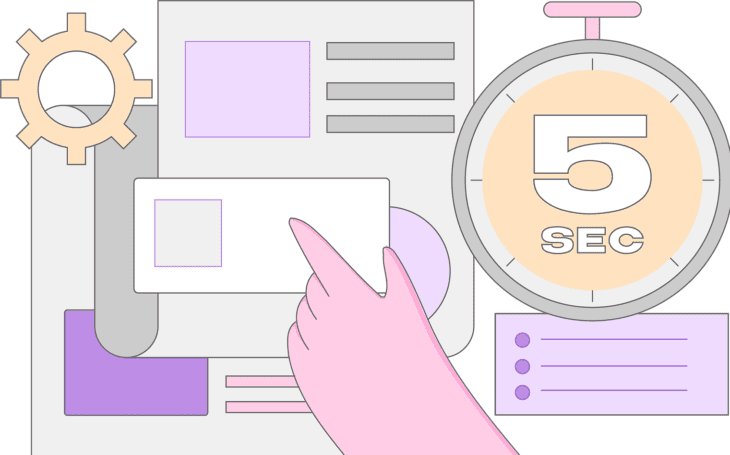
Want to find out what users think about your designs at first glance? We recommend trying out a 5 second test using our UserQ platform.
But what is a 5 second test, exactly? What does the test involve? And why are they so effective for gaining both qualitative and quantitative data to improve the quality of your digital products?
In this guide, we give a step-by-step tutorial on how to create, run, and analyse a 5 second test using our platform.
What is a 5 second test?
It’s a user research tool that measures first impressions of a digital product. The aim is to gauge what people like and dislike about your design, what’s right and wrong about your first mock-up – all within the first 5 five seconds.
Although they’re most commonly used for websites and apps, 5 second tests are also effective for measuring first impressions on specific design elements including logos, images, graphics, fonts, etc.
No matter what you’re getting feedback on, you can gain valuable quantitative and qualitative data that helps you make smarter, more informed decisions based on what users think and feel about you. It’s all about getting the insights you need to help shape your products for the better.
We also recommend re-running 5 second tests with edited and amended designs. That way you can level up and repeat until you’re 100% happy with the results of your finished product and that the feedback is what you want it to be.
What does a 5 second test involve?
It’s pretty simple. Participants will be shown the design for 5 seconds only and then asked a series of questions based on their initial reactions to what they’ve just seen. The 5 second test questions can include a variety of things such as:
- Do you remember the company name?
- What information can you recall?
- Did the website seem trustworthy and professional?
- Who do you think the intended user is?
- Do you understand the main features of the website?
- How did the design make you feel?
The questions you ask depend on what you want to measure and find out about your users’ first impressions. For example, if you want feedback on your website’s design, be sure to ask design-focused questions based on the site’s visual elements and overall aesthetics.
Or if you’re after an understanding of how well your brand message comes across on your website, ask plenty of brand-led questions. After all, you don’t want users having to guess what you and your site’s about.
Why five seconds?
Well, many scientific studies show that the average online browser spends just a few seconds on a website before deciding whether they want to leave or not — so first impressions count!
How to run a UserQ 5 second test
Now that we’ve explained exactly what a 5 second test is, it’s time to create yours…
Step 1: create a new test
- From your personal dashboard, click ‘Create new test’ and then ‘5 second test’.
- Select your test language (English or Arabic) and name your new test. While the researcher platform will not show in Arabic, the entire participant experience will be Arabic-friendly (from right to left). If you do choose Arabic, remember to switch your keyboard to Arabic and make sure that all your test inputs are written correctly.
Create test, choose type of test
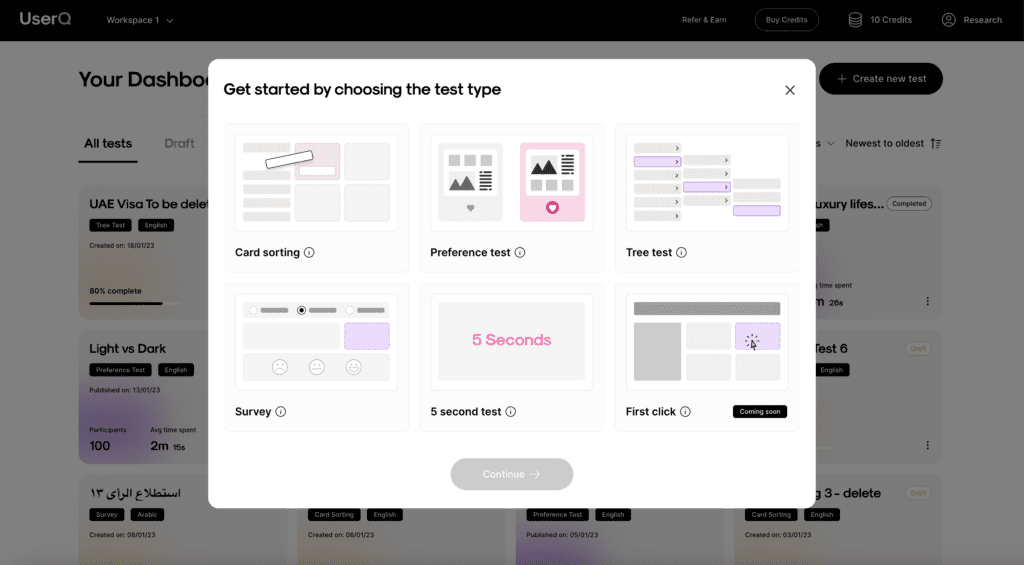
Tip: your test name is visible to participants…make it appropriate.
Step 2: edit your welcome page
This is your chance to introduce participants to the 5 second test they’re about to take part in.
By default, a generic title and description are already pre-populated. You can choose to proceed without making any changes to them, or personalise your own…
- Add a welcome page title, and write a custom welcome message.
- Personalise with a photo to give the user visual cues about the topic.
- If the language is set to Arabic, the pre-populated text will already be translated into Arabic too – so remember to write in Arabic if you want to make changes.
Create test, edit welcome page
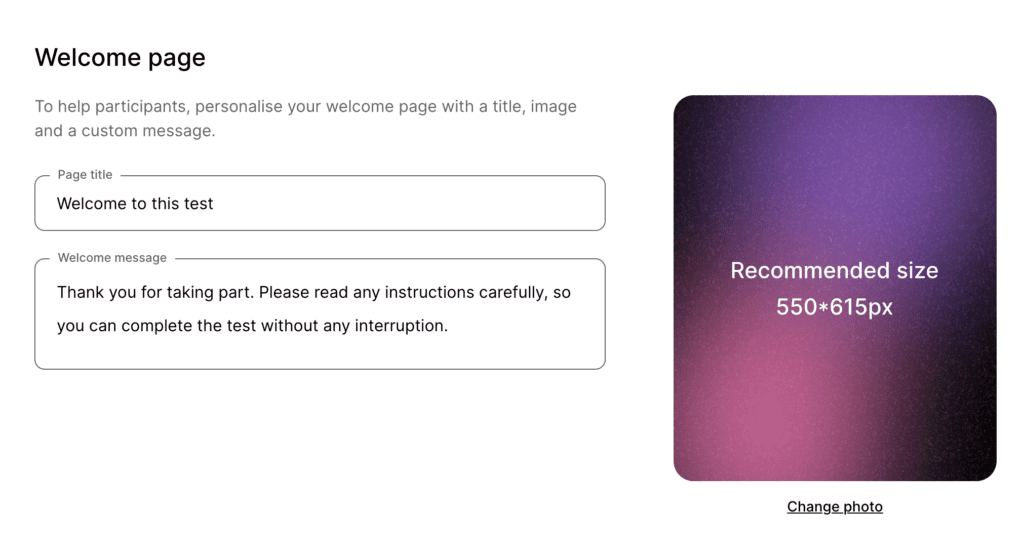
Step 3: add introductory questions (optional)
These questions help you gain deeper insights into who your participants are.
- Add custom questions that you want to ask participants, before the 5 second test begins.
- There are six types of questions you can choose from: Free text, Single choice, Multiple-choice, Likert scale, Ranking scale, and Rating scale.
- You can add up to five introduction questions. We’ve set this maximum because we don’t want your participants to lose attention before the test event starts!
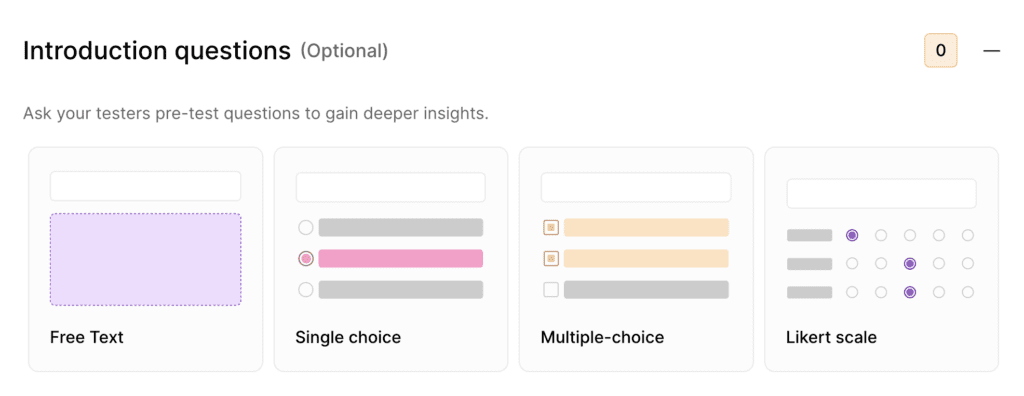
Step 4: build the test
Where you’ll find everything you need to create your 5 second test, including your tasks and design upload…
a. Create the task
The task details will be shown to the participant prior to introducing the design.
- Write your task in the ‘Task description’ box.
- For example, you might set a task like: ‘Take a look at these designs and tell us what you recall.’
5 second test_create task

Tip: keep the task simple and straightforward to put your participants at ease. The task description is your chance to let them know the purpose of the task ahead.
b. Upload your design
Next, select the design you want participants to view. You can upload one design image only.
By default, the image will be shown to participants for 5 seconds only. Research shows this is just enough time for users to remember certain key aspects of it.
- Drag and drop to upload the file OR press the ‘Upload’ button to upload the file from your computer drive.
- Add and edit the background colour (it’s a good idea to select a darker or bolder background colour to contrast a white logo).
- Change the design name in the edit box.
- The file formats supported are: JPG, JPEG, PNG, GIF, or MP4.
- The max file size is: 2MB for images and 4MB for video.
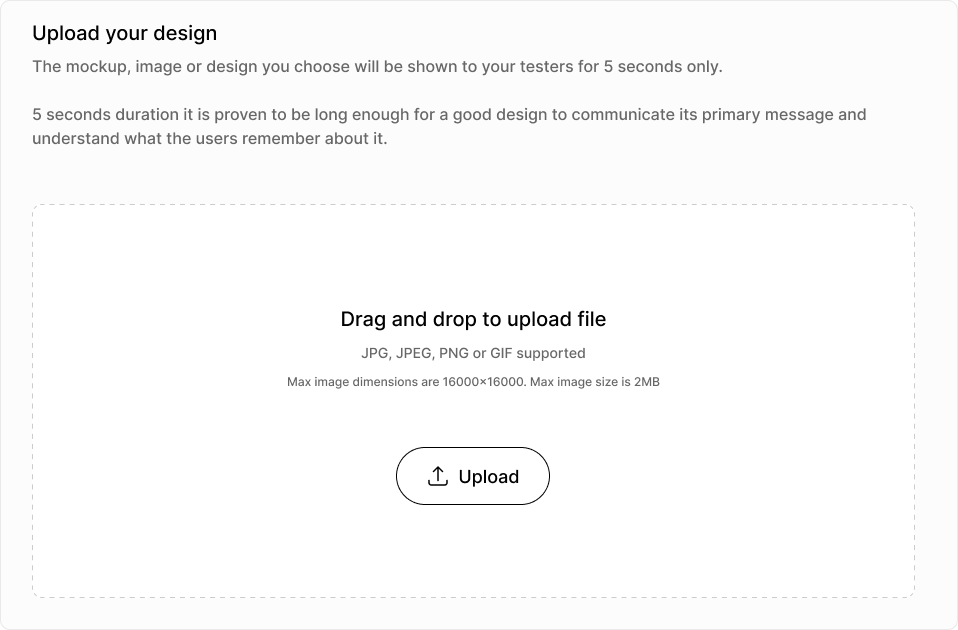
Tip: preview the test by clicking on the ‘Preview test’ box in the top right-hand corner. This will show you exactly what participants see from their end.
- The design will show as soon as participants click ‘Show the design’.
- A 5-second timer will only start once the whole image has loaded (so don’t worry too much about slow WiFi)
c. Write your follow up questions
These are what you want to ask participants regarding the design they’ve just seen.
- Add custom questions.
There are six types of questions you can choose from: Free text, Single choice, Multiple-choice, Likert scale, Ranking scale, and Rating scale.
Tip: we recommend using open-ended questions to gain more in-depth qualitative feedback, including what they can recall or what grabbed their attention. They also avoid the risk of cognitive bias because you’re leaving it up to the participant to say exactly what they think or feel – rather than subconsciously hinting at the answers for them.
Step 7: edit your thank you page
Here you can thank the participants for their time and show your appreciation.
- Customise your page title, and write a personalised thank you message.
- Add a custom photo.
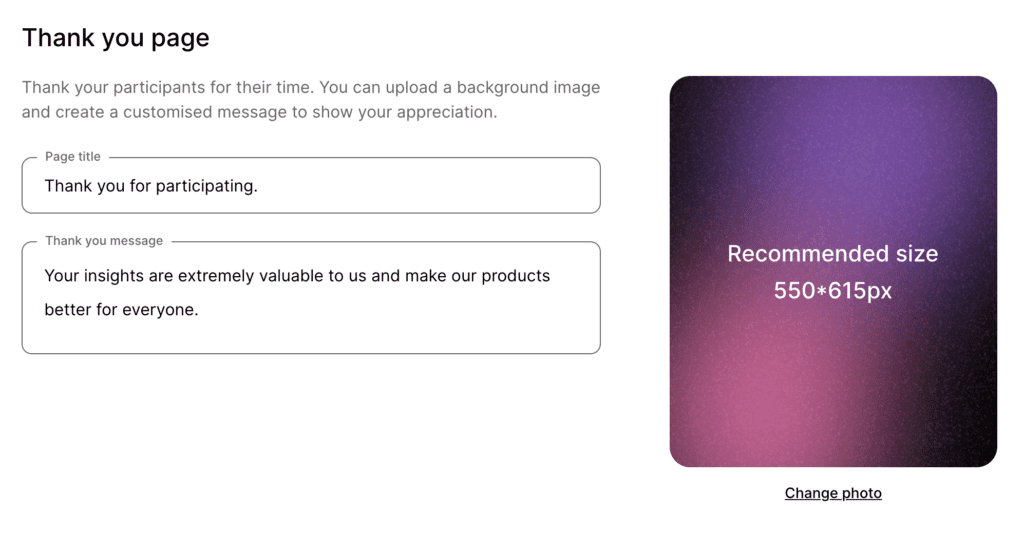
Step 8: Recruit your participants
Once the test has been built, it’s time to publish it. Start by finding participants…
You can either choose to recruit from the UserQ panel or share the link with your own participants.
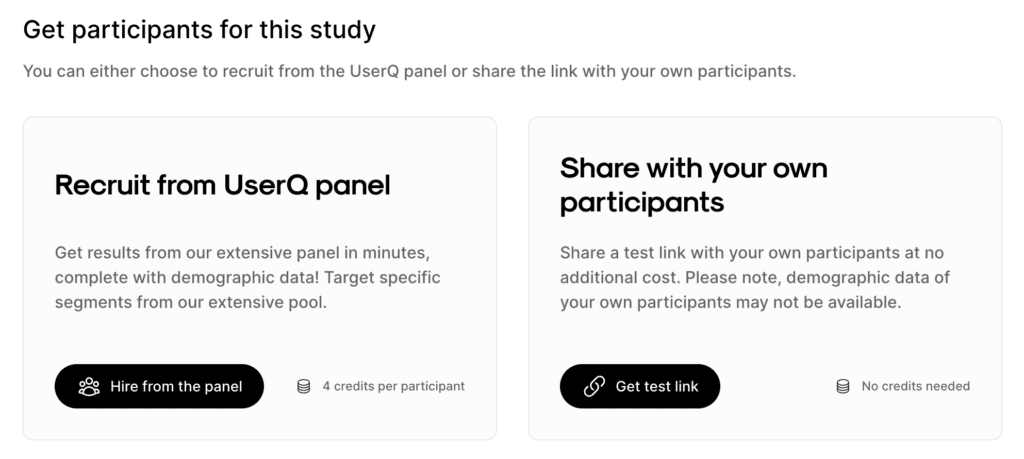
a. Recruit from UserQ panel
If you want to use your own participants, skip to step b.
- Click ‘Hire from the panel’.
- Choose how many participants you want to recruit by using the slider or the input field.
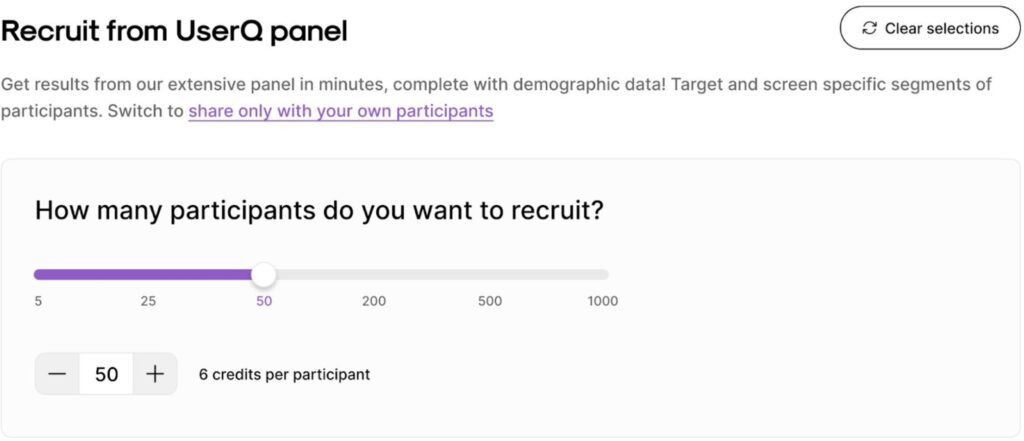
i. Filter by Demographics
Next, switch on the demographic filtering feature, where you can target participants from a variety of demographics, including age, gender, nationality, etc. Use our estimated panel size widget (on the right) for real-time information on how many testers we have in our pool, based on your selected demographics. It also provides feedback on your survey’s results speed, ie. how long you’ll have to wait to get all the results.
The broader the panel, the faster the results come in.
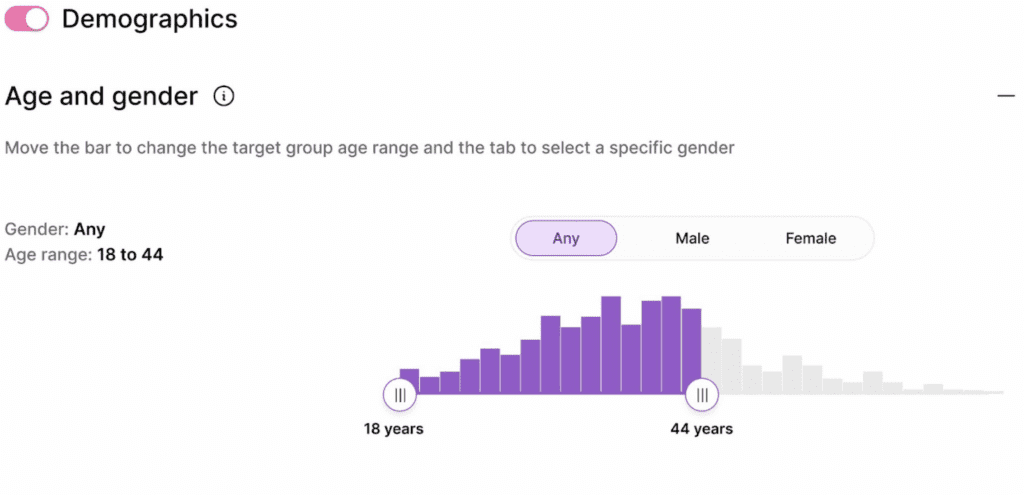
Tip: customise your participant pool to the target market of your digital product. For example, if you’re creating a 5 second test for an online store that operates solely in the UAE, you’ll likely get the best, most valid results if you select participants who reside in the UAE.
ii. Add screening questions (optional)
Toggle this option, to add screening questions to your study. These questions will appear one-by-one to the tester as ‘pre-test questions’. Their responses will determine whether they are eligible to continue to the study.
You can add up to a maximum of 3, single-choice questions to identify the most suitable participants for your study. Each question can have a maximum of 5 responses and must be classified as either a good fit or no fit.
Good fit = Responses that match your criteria for the study and are eligible to take the test or continue on to the next question (in the case of multiple screener questions). Your credits will be spent only on the “Good fit” participants.
Not fit = Response that are not a good fit for the study and the tester will not be able to access the test.
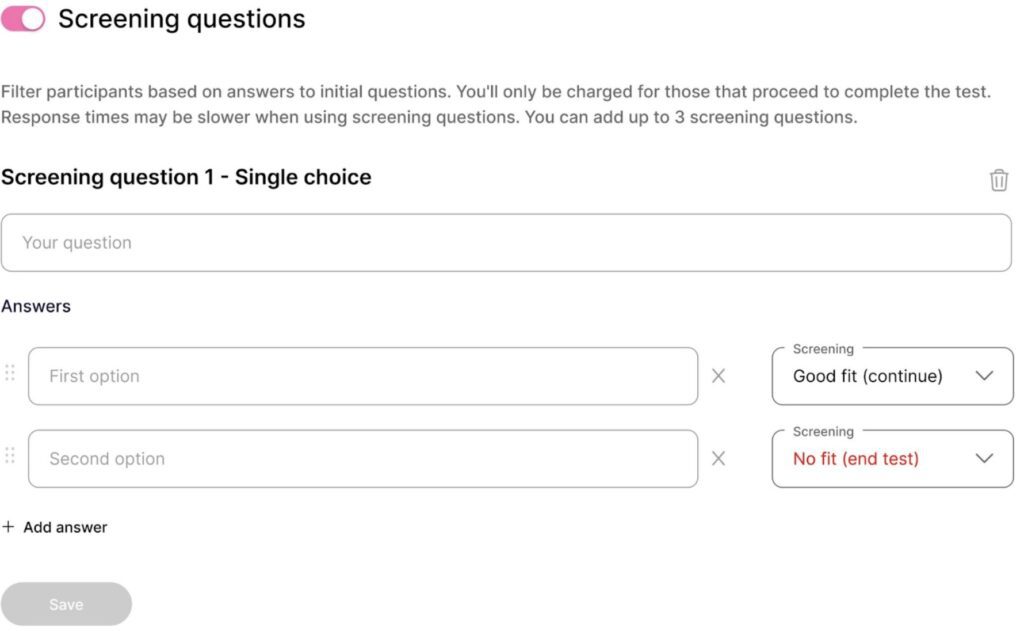
Bonus Tip: Identify your target audience by asking them pre-test questions. For example, if you’re creating a survey for a car company operating in the UAE, add screener questions to your study like, “Do you have a valid UAE driver’s license?” or “Do you own a car?”. This ensures that the data collected is relevant to your research and enables you to make informed decisions.
b. Share with your own participants
You can share the link with your own testers panel at no extra cost. However, we recommend recruiting from our UserQ panel due to you getting full use of our wide-reaching participant demographic data, including: age, gender, nationality, residency, confidence with technology, employment status, and household status. By using this data, there’ll be no need for you to ask demographic questions in the test itself.
Step 9: publish
- Review your order summary (including your total participants and required credits for recruitment and publishing fee)
- In the case of an outstanding credit balance, you’ll need to process a payment.
- Once everything’s set up how you want it, click ‘Publish’.
Tip: apply a promo code if you’ve got one.
Congratulations, your 5 second test is now live.
You’ll get a shareable link for the test, no matter whether you’ve selected a UserQ panel or have chosen your own participants only.
Build your 5 second test today
Are you ready to build your 5 second test? Join as a researcher and you’ll get the feedback you need in just minutes.
Need help with building your 5 second test? We can lend a hand.
Send a message to: support@userq.com to get in touch. We’re always happy to answer any questions you might have.
Related Post

Tree testing guide: How to
Want to build a fully functional tree test the easy way? Here at UserQ, we’ve got the tools you need
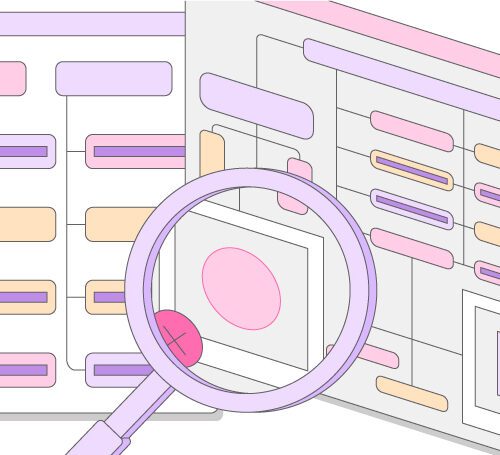
Tree testing guide: Analyse tree
You’ll have access to the results as soon as the tree test is published. The findings of your test show

Card sorting guide: How to
Want to build simple and easy-to-use card sorting tests? You can with UserQ. Our pay-as-you-go user testing platform allows you
Subscribe to our
product newsletter!
Receive emails about UserQ updates, new features,
offers and latest trends.


